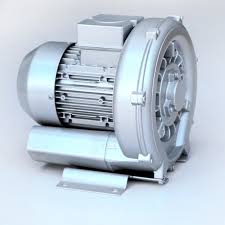Turbo blowers
Turbo blowers are specialized devices used to generate high volumes of compressed air or gas with relatively low energy consumption. They are commonly utilized in various industrial applications, including wastewater treatment, pneumatic conveying, and process air supply. Here’s a comprehensive overview of turbo blowers, including their features, advantages, applications, and maintenance considerations:
- Features of Turbo Blowers
High Efficiency: Turbo blowers are designed to operate at high efficiency, making them suitable for applications requiring significant airflow and pressure with lower energy costs.
Variable Speed Drives (VSD): Many modern turbo blowers come equipped with variable speed drives, allowing for precise control of airflow and energy consumption according to demand.
Compact Design: Their compact design saves floor space in industrial settings while providing effective performance.
Low Noise Levels: Turbo blowers generally operate more quietly compared to traditional blowers, which is beneficial in noise-sensitive environments.
Advanced Control Systems: Many models incorporate sophisticated control systems for optimized performance and energy management.
- Advantages of Turbo Blowers
Energy Savings: Due to their high efficiency, turbo blowers can significantly reduce energy consumption compared to other types of blowers.
Reduced Operating Costs: Lower energy usage translates into reduced operational costs over time, making turbo blowers a cost-effective solution.
Flexibility: Turbo blowers can be adjusted to meet varying airflow and pressure requirements, making them suitable for a wide range of applications.
Reliability: With fewer moving parts compared to positive displacement blowers, turbo blowers typically require less maintenance and have a longer lifespan.
- Applications of Turbo Blowers
Wastewater Treatment: Used for aeration in biological treatment processes, helping to maintain the necessary oxygen levels for microbial activity.
Pneumatic Conveying: Employed in conveying materials such as grains, powders, and pellets in various manufacturing processes.
Chemical and Process Industries: Used for supplying process air, facilitating combustion, and assisting in chemical reactions.
HVAC Systems: Utilized in heating, ventilation, and air conditioning systems for air supply and circulation.
- Maintenance Considerations
Regular Inspections: Routine inspections are essential to ensure optimal performance and to detect any potential issues early.
Air Filter Maintenance: Keeping air filters clean and replaced regularly helps prevent dust and contaminants from entering the blower, prolonging its life.
Monitoring System Performance: Using performance monitoring tools can help track efficiency and detect anomalies in operation.
Lubrication: Ensure that bearings and moving parts are adequately lubricated according to the manufacturer’s recommendations.
- Selection Criteria
Flow Rate and Pressure Requirements: Understanding the specific flow and pressure requirements of your application is crucial for selecting the appropriate turbo blower.
Energy Efficiency: Look for models with high efficiency ratings to maximize energy savings.
Size and Space: Consider the physical dimensions of the turbo blower and available installation space.
Control Capabilities: Evaluate the control options available, such as VSDs, to ensure the blower can adapt to varying operational needs.
Conclusion
Turbo blowers are an efficient and versatile solution for a wide range of industrial applications, particularly where high airflow and low energy consumption are required. Their advanced technology, combined with lower operational costs and maintenance needs, makes them an attractive choice for businesses looking to optimize their air supply systems. When selecting a turbo blower, it is essential to consider the specific requirements of your application to ensure optimal performance and efficiency.
Compact power in aeration tanks.
AERZEN turbo blowers. Over the decades we have developed these packaged units to technical excellence. In doing so we have acquired expertise that sets standards throughout the world. This is reflected in improved energy efficiency, low life-cycle costs and specially developed core components. To sum it up: it can be seen in every detail of AERZEN’s continuous flow machines.
Magnet vs. air foil bearing – AERZEN air foil bearing: more than one step ahead!
SIMPLE AND EFFECTIVE: AIR AS BEARING SYSTEM
Construction and functional principle of a turbo blower from AERZEN are simple and at the same time effective. As the air supply of modern wastewater treatment plants is clearly designed for maximum availability, high energy efficiency and long maintenance cycles, AERZEN uses for the demanding bearing system within turbo blowers neither oil nor other lubricants – but simply air.
blower & vacuum
Positive Displacement Blowers
Screw Compressors
Rotary Lobe Compressors
Turbo blowers
Where is a blower motor located?
Can a car run without a blower motor?
How do you know if your blower motor is bad?
How do you Unflood a leaf blower?
How do you fix a leaf blower that won’t start?
How do you start a leaf blower?
What is the difference between a blower and a fan?
What does blower motor do?
Can you use a leaf blower on wet leaves?
Are leaf blowers worth it?
Should I get a leaf blower or vacuum?
How does a Roots blower work?
What is the difference between a Roots blower and a screw blower?
What is a lobe blower?
What is the difference between fan blower and compressor?
What is a rotary blower?
How does a rotary lobe blower work?
What’s the difference between a fan and a blower?
What is a rotary screw air compressor?
